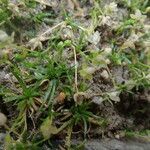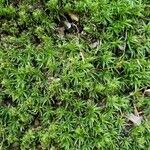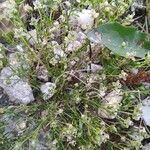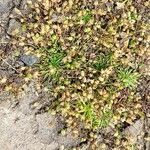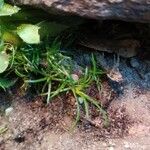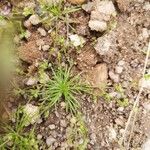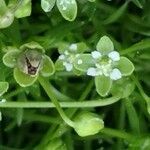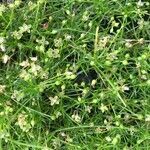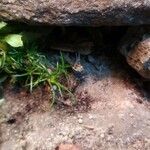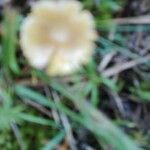Glabrous, branching perennial, prostrate to ascending, the stems 2–10 cm; lvs linear-subulate, 3–10(–15) mm, to about 1 mm wide, mucronate or shortly aristate, sometimes minutely ciliate, frequently subtending short shoots or lf-fascicles; fls solitary or few at the tips of the stem and branches, or some of them on axillary pedicels, often nodding after anthesis, but finally erect; sep 4(5), 2–2.5 mm, spreading after maturity; pet shorter than the sep, or none; stamens as many as the sep; fr about equaling the sep, commonly 2–3 mm; seeds 0.3–0.5 mm, flattened, obliquely triangular, sulcate along the 2 dorsal angles, very finely roughened; 2n=22. Moist soil and rocky places, often a weed in paths or pavements; circumboreal, s. in Amer. to Md., Mich., and Kans. Summer.
Perennial, rarely annual or biennial herbs, forming dense or loose, 2-5 cm high tufts. Stems slender, glabrous, with a basal leaf rosette producing numerous procumbent, rooting sidebranches. Leaves linear subulate to almost filiform, glabrous or rarely ciliate, mucronate, 5-12 mm long, joined at the base. Flowers solitary in the leaf axils. Sepals 4, broadly ovate, obtuse, green, with a very narrow scarious margin, without visible veins. Petals 4, broadly ovate, half as long as the petals or less, rarely absent. Stamens 4, rarely 5, episepalous and shorter than sepals. Styles 4, shorter than ovary. Capsule about twice as long as the first appressed and later patent persistent sepals, opening by 4 obtuse valves. Seeds brown, c. 0.3 mm, papillose, with a dorsal furrow.
Herb, perennial, with fibrous roots, often adventitious from nodes, glabrous or rarely minutely ciliate. Stems mat-forming, to 20 cm long, with a dense, non-flowering, central leaf-rosette. Leaves linear-subulate, acuminate, ± mucronate, 5–15 mm long, 0.3–0.8 mm wide, glabrous or ciliate. Flowers 4 (5)-merous, c. 4 mm diam.; pedicels 5–20 mm long, glabrous, erect in flower, then curving and again becoming erect in ripe fruit. Calyx glabrous. Sepals broadly ovate to suborbicular, 2–2.5 mm long, with narrow, scarious margins, spreading in ripe fruit. Petals minute, white, often absent. Stamens 4 (5). Styles 4. Capsule ovoid, longer than sepals, 2–4 mm long. Seeds obliquely reniform, 0.3–0.5 mm wide, dark brown, ± grooved dorsally, weakly to strongly tuberculate.
Perennial. Stems procumbent or rarely ascending, slender but not filiform, glabrous, (2)-5-10-(20) cm long; axillary fascicles of lvs present; adventitious roots sometimes present at nodes. Rosette lvs short-lived. Cauline lvs linear, hyaline at base, glabrous or with minute marginal cilia, aristate at apex, (3)-5-10-(15) × 0.2-0.5 mm. Fls small, 4-(5)-merous. Pedicels glabrous, (5)-10-15-(20) mm long. Sepals obtuse, glabrous, 1.5-2-(3) × 1-1.5 mm; hyaline margins always green. Petals very small to c. 3/4 length of sepals, rarely 0. Stamens 4-(5). Capsule ovoid, slightly > calyx; styles and valves 4-(5). Seeds brown, triangular-ovoid, papillate, 0.4 mm long.
Herbs perennial. Stems ascending or procumbent, 3--10 cm tall, slender, branched, glabrous. Leaves linear, 2--10 × 1--2 mm, shortly aristate, glabrous or ciliate. Flower solitary, terminal or axillary. Pedicel recurved after anthesis, erect in fruit, slender. Sepals 4, broadly ovate, 1.5--2 mm, margin white, apex obtuse. Petals 4, ovate, shorter than sepals. Stamens 4 (rarely 8). Styles 4. Capsule ovoid, longer than sepals, 4-valved. Seeds black-brown, triangular, grooved, smooth. Fl. Jul--Aug, fr. Sep--Oct. 2n = 22.
